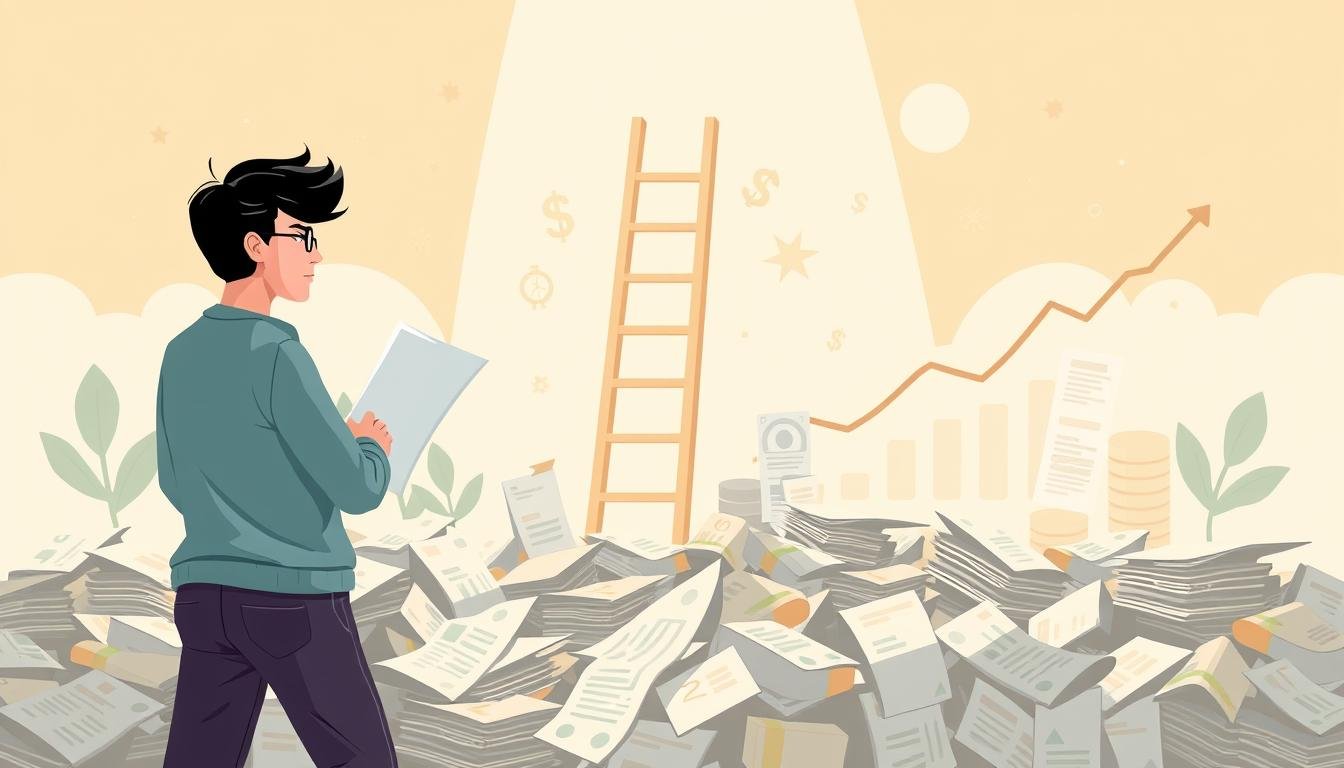Dealing with debt can feel like a huge burden. It affects not just your money but also your mind. It’s key to find good debt repayment strategies to get back in control.
To pay off debt quickly, you need discipline, the right plan, and a clear view of your finances. Using proven methods can help you manage and clear your debt efficiently.
This article will show you effective strategies for paying off debt. It aims to guide you through the process and help you achieve financial freedom.
Key Takeaways
- Understand your debt to create an effective repayment plan.
- Prioritize debts with the highest interest rates.
- Consider debt consolidation for simplified payments.
- Create a budget that allocates a significant portion towards debt repayment.
- Avoid new debt while paying off existing balances.
Understanding Your Debt Situation
To manage your debt well, you need to know all about it. This means listing all your debts and how they affect your money. It’s key to understanding your financial health.
Creating a Complete Debt Inventory
Begin by making a list of all your debts. This includes credit cards, personal loans, and mortgages. Also, note the balance, interest rate, and minimum payment for each.
Calculating Your Debt-to-Income Ratio
Your debt-to-income ratio shows how much of your income goes to debt. To find it, divide your total monthly debt payments by your monthly income before taxes.
| Debt Type | Balance | Interest Rate | Minimum Payment |
|---|---|---|---|
| Credit Card | $2,000 | 18% | $50 |
| Personal Loan | $10,000 | 6% | $200 |
| Mortgage | $150,000 | 4% | $800 |
Prioritizing Which Debts to Tackle First
After understanding your debt, decide which to pay off first. You can use the debt avalanche method, focusing on high-interest debts. Or, you can follow the debt snowball method, starting with the smallest debt.
How to Pay Off Debt Quickly: Tips That Work
Getting out of debt is achievable with the right plan. There are many ways to tackle debt. It’s not just about making payments; it’s about having a strategy that fits your situation.
The Debt Avalanche Method
The debt avalanche method focuses on debts with the highest interest rates first. This method can save you a lot of money in interest over time.
Focusing on High-Interest Debts First
Start with debts that have the highest interest rates. For example, if you have a credit card with 18% interest and a personal loan at 6%, pay off the credit card first.
Calculating Your Interest Savings
Calculate the interest savings for each debt. Use a debt repayment calculator or a spreadsheet. For instance, paying off a $2,000 credit card balance with 18% interest in 12 months instead of 24 months saves a lot of interest.
| Debt Type | Interest Rate | Balance | Monthly Payment | Total Interest Paid |
|---|---|---|---|---|
| Credit Card | 18% | $2,000 | $183 | $236 (12 months) |
| Personal Loan | 6% | $10,000 | $456 | $1,200 (24 months) |
The Debt Snowball Method
The debt snowball method involves paying off debts from smallest to largest, regardless of interest rate. This method gives quick wins and boosts motivation.
Building Momentum with Small Wins
Eliminate smaller debts first for a sense of accomplishment. For example, paying off a $500 medical bill before a $5,000 car loan can be very motivating.
Debt Consolidation Strategies
Debt consolidation combines multiple debts into one loan, often with a lower interest rate. This simplifies your finances and can save money.
When Consolidation Makes Sense
Consolidation is wise when you get a lower interest rate or simpler payments. Make sure the consolidation loan’s rate is lower than your current debts’ average rate.

In conclusion, paying off debt quickly needs a solid strategy. Choose the debt avalanche, debt snowball, or consolidation method that suits you best. Stick to your plan to achieve financial freedom.
Finding Extra Money to Accelerate Debt Payoff
Finding extra money is key to paying off debt faster. To reach financial freedom, you need to put as much as you can towards your debt.
Creating a Bare-Bones Budget
A bare-bones budget only includes the basics. By cutting back on things you don’t need, you can save more for debt. Try the 50/30/20 rule: 50% for needs, 30% for wants, and 20% for savings and debt.
Side Hustles That Generate Quick Cash
Side hustles can really help with debt. You can try freelancing, driving for a ride-sharing service, or selling online. Even selling things you no longer need or offering pet-sitting can help.

| Strategy | Description | Potential Savings |
|---|---|---|
| Negotiating Lower Interest Rates | Contact creditors to lower interest rates on debts | Up to 5% reduction |
| Using Windfalls Wisely | Direct tax refunds or bonuses towards debt | Variable, based on windfall amount |
Negotiating Lower Interest Rates
Talking to creditors can get you lower interest rates. Be ready to share your financial situation and ask for a lower rate.
Using Windfalls Wisely
Use unexpected money like tax refunds or bonuses for debt. This can really speed up your progress.
Achieving Financial Freedom
To pay off debt fast, you need to understand your debt, use smart strategies, and find extra money. Start by making a list of all your debts. Then, sort them by interest rate or balance to focus on the most important ones first. This approach can help you reach financial freedom faster.
Speed up your debt repayment by living on a tight budget and getting a side job. You can also try to get lower interest rates on your debts. Using unexpected money wisely can give you a big advantage. These steps will help you on your way to paying off debt fast.
Getting to financial freedom is possible with a solid plan and discipline. By managing your debt well and making smart money choices, you can secure a better financial future.
